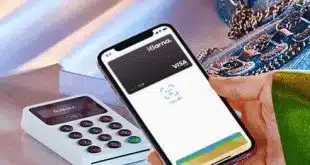A startup company says it is probably 12 to 18 months away from piloting a contactless payment card that will incorporate both chip-based radio-frequency identification and biometric authentication technology. Up to now, RFID-based payment pilots and programs have not included PINs or any other means of authenticating users. But 2-year-old Innovative Connection Corp., Richardson, Texas, is developing an RFID device that incorporates a fingerprint reader that communicates with a chip embedded in the device, which could be a card or some other token, such as a memory stick. The reader, or sensor, is an amorphous-silicon film similar to the material of which flexible, flat-panel screens are made. If the digitized reading of the user's fingerprint matches the template stored in the chip, the transaction can proceed. After its pilots, Innovative plans to have a production model ready by 2007, says Glenn Palmer, chief executive of Innovative and an industrial engineer. He expects cards will cost $5 to $10 each in quantity when commercial production begins, and he predicts a market of “tens of millions” of shipments. The payback will come from faster tender times and leverage to negotiate lower interchange rates because of the near-elimination of fraud, he says. Transactions should take about three seconds, he figures, even with the fingerprint comparison. If this proves out, it will be faster than tender times other RFID pilots have achieved. And with digitized fingerprints stored locally on the card, there are no privacy issues. “There's going to be a merging of biometrics with RFID,” Palmer says. Meanwhile, his company, which will shortly change its name to Rampart-iD Systems Inc., has attracted notice from at least one major processor. Electronic Data Systems Corp., based nearby, plans to serve as a systems integrator, introducing the cards into both payments and health-care applications. Innovative has had to solve a number of vexing problems to get this far. It has reverse-engineered its technology, Palmer says, so that its cards will be compatible with existing payment terminals and RFID receivers. It is also working on making its devices work without batteries. Power would instead come from the static-electricity field created by nearby RFID readers. This should allow the cards to be no thicker than a conventional credit card. Innovative has three patents pending so far, Palmer says. “This [RFID product] has been our life,” he says, since the company formed in 2002. But the technology faces the same challenge other RFID projects do: getting readers installed at the point of sale. “The challenge is acceptability,” says Vinnie Calo, senior director of card processing services at EDS. “We have to get those readers out.” With RFID payment, cards or other tokens transmit account data to nearby receivers, after which transactions proceed as they would after a conventional card swipe. The most ambitious deployment of the technology so far in payments is that of ExxonMobil Corp., whose program is called Speedpass. But both MasterCard International (PayPass) and American Express Co. (ExpressPay) have also introduced RFID systems. Palmer says he will start with deployments in the physical- and computer-access markets. These, he says, are about four months away. Then Innovative will move into payments. He says the company will produce either cards or memory sticks, depending on the requirements of the issuer.
Check Also
As Data Drives Sales, Shift4 Adds A Business Intelligence Module to Its SkyTab POS System
Shift4 Payments Inc. says it has added a new business-intelligence module to its SkyTab POS …






